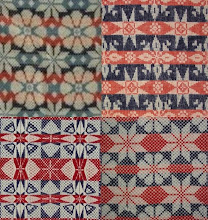






The first draft, Fig. 1, is of a coverlet in the author's possession. It is a nice use of four blocks, woven brick-fashion. The coverlet was expertly woven using very fine cotton 3-ply warp yarns, very fine cotton singles wefts and tightly spun 2-ply indigo wool pattern wefts.
There were occasional shed defects, some slubs where cotton yarns were tied together, and just one treadling error. The pattern matches nearly perfectly at the center seam. No border design was threaded and woven. The foot ends in woven fringe with a leno treatment, and similar fringe was separately woven then sewn to each of the long sides.
The red and blue coverlet with star and leaf/tulip cluster similarly uses ovals for a leaf or 4-petaled flower. This required 20 harnesses and treadles. It is identical to an unpublished draft in the Pattern Book of weaver David Bender (draft: p. 63; drawing: No. 7, p. 59, entitled "Jackson's Beauty"). A very similar draft is in the pattern book (Diaber Book) owned by weaver Jacob Angstadt, published by Ruth Holroyd in 1996 (pp. 85-87, 90). Another draft, identical to this coverlet's and to David Bender's draft, is in a manuscript that belonged to weaver Benjamin Delong, of Berks County, Pennsylvania, in a private collection (No. 48 in the manuscript). The Delong manuscript is unique in having a second draft of the same basic design, which differs in the form of the small 'rose' between the stars, and in the form of the star center (No. 47).
The three coverlets known in this design have slightly different tie-ups. Fig. 2 is a draft of this coverlet. The typical summer-and-winter two-tie structure is in the draft, but the tieup uses just one of the tie-harnesses as structural tie. The two other similar coverlets utilize the other tie-harness, which produces a slight differentce in the ribbing effect. This coverlet's warp is 2-Z-ply S-spun unbleached cotton. The cotten weft is the same as the warp, and the dark blue and orange-red pattern wools are also 2-Z-plied S-spun. It has tape-loom fringe added on three sides, made of cotton and wools that look the same as the coverlet's fibers.
The three coverlets known in this design have slightly different tie-ups. Fig. 2 is a draft of this coverlet. The typical summer-and-winter two-tie structure is in the draft, but the tieup uses just one of the tie-harnesses as structural tie. The two other similar coverlets utilize the other tie-harness, which produces a slight differentce in the ribbing effect. This coverlet's warp is 2-Z-ply S-spun unbleached cotton. The cotten weft is the same as the warp, and the dark blue and orange-red pattern wools are also 2-Z-plied S-spun. It has tape-loom fringe added on three sides, made of cotton and wools that look the same as the coverlet's fibers.
While Jacob Angstadt, his weaver brother Benjamin and their master-weaver paternal grandfather were all from Berks County, PA, along with Benjamin Delong, David Bender (1826-1882) was born and raised in Westmoreland Co., PA. David's father Jacob was a weaver, and Jacob Bender's paternal grandfather and some brothers and uncles were also weavers. Jacob was born in Northampton Co., PA, but his parents were in Westmoreland by 1799. David's manuscript was probably largely compiled by his father (in part from published sources) -- how the draft like this coverlet's came to the Benders, and who "Jackson" was, are unknown.
The coverlet with flower and starburst is also a multiple-harness summer-and-winter example, but this one uses both tie-harnesses as structural ties. It, too, was woven on 20 harnesses and treadles. Its warps are fine singles used doubled. The wefts are fine unbleached cotton Z-spun singles, and dark blue and orange-red wool 'S' singles, two-plied. The coverlet unusually has cotton tabby at both head and foot. Fringes on 3 sides are extensions of the warp at the foot and of the pattern wefts at the side edges.
This coverlet's draft (Fig. 3) shows the simple border composition. No published version of this draft is known so far. Two other coverlets in this design are known, but they were woven on 18 harnesses and treadles. One is in a private collection, the other now in the Museum of the American Coverlet in Bedford, Pennsylvania. A fragment of a third similar coverlet, in fragmentary form, was in the Harriet Tidball collection, now in the Henry Museum, University of Washington, Seattle. This piece has 8-pointed stars instead of the starburst motif. The three whole coverlets have provenance from southeastern Pennsylvania, but so far their true history is unknown.





